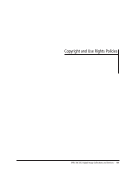SPEC Kit 335: Digital Image Collections and Services · 187
WASHINGTON UNIVERSITY IN ST. LOUIS
Digital Project Support Framework
http://digital.wustl.edu/create/Digital_Project_Framework_Rev_L.doc
when direct funding runs out. One of the goals of this framework is to propose a
method to retain digital projects (or their contents) over decades, thus improving
their value as scholarly work.
2) Content (digital asset) management – Content or digital asset management is
important to the long-term success of the entire digital library endeavor. By
properly segregating content from presentation—and even within these
categories, separating data from metadata and static presentation from tool
development—projects better ensure their longevity, and help clarify the roles of
the scholars and curators involved. Once these pieces of a digital project are
elucidated, it is easier for the library to ingest the data, and for scholars to study
and share the resources across projects.
3) Value as a scholarly activity – Finally, digital projects and their contents present
the same problem of recognized scholarly effort that any book or paper presents.
How does one determine if a project is of scholarly value and should be
preserved? There are established mechanisms in the print world for this
evaluation. Peer-reviewed journals, book publication procedures, and library
selection processes are all part of this process. Currently, similar mechanisms are
not as codified in the digital world. Although this framework does not address the
issue of scholarly value directly, it does maintain that the University must decide
whether a project is worth long-term financial investment.
6 PROPOSAL
There are five elements to this proposed framework:
1. Recognition of Presentation/Content Structure
2. Establishment of a Common Set of Project Definitions
3. Establishment of a University Digital Asset Repository
4. Establishment of a University Digital Library
5. Establishment of a Digital Project Web Portal
6.1 Presentation/Content Structure
It is important to recognize a distinction between 1) developing and preserving digital
content and 2) developing presentation and tools. This distinction will help clarify the
responsibilities and investments required of various parties in the development of digital
projects.
6.2 Common Set of Project Definitions
The following sections offer categories for describing a digital project’s 1) support
(divided into four classes), 2) approach to content, and 3) hosting.
6.2.1 Project Classes
A project’s class defines how much support the school or University has commited to
the project. If a school or the University commits significant support to a project,
resources will need to be specifically allocated to the project. This proposal does not
WASHINGTON UNIVERSITY IN ST. LOUIS
Digital Project Support Framework
http://digital.wustl.edu/create/Digital_Project_Framework_Rev_L.doc
when direct funding runs out. One of the goals of this framework is to propose a
method to retain digital projects (or their contents) over decades, thus improving
their value as scholarly work.
2) Content (digital asset) management – Content or digital asset management is
important to the long-term success of the entire digital library endeavor. By
properly segregating content from presentation—and even within these
categories, separating data from metadata and static presentation from tool
development—projects better ensure their longevity, and help clarify the roles of
the scholars and curators involved. Once these pieces of a digital project are
elucidated, it is easier for the library to ingest the data, and for scholars to study
and share the resources across projects.
3) Value as a scholarly activity – Finally, digital projects and their contents present
the same problem of recognized scholarly effort that any book or paper presents.
How does one determine if a project is of scholarly value and should be
preserved? There are established mechanisms in the print world for this
evaluation. Peer-reviewed journals, book publication procedures, and library
selection processes are all part of this process. Currently, similar mechanisms are
not as codified in the digital world. Although this framework does not address the
issue of scholarly value directly, it does maintain that the University must decide
whether a project is worth long-term financial investment.
6 PROPOSAL
There are five elements to this proposed framework:
1. Recognition of Presentation/Content Structure
2. Establishment of a Common Set of Project Definitions
3. Establishment of a University Digital Asset Repository
4. Establishment of a University Digital Library
5. Establishment of a Digital Project Web Portal
6.1 Presentation/Content Structure
It is important to recognize a distinction between 1) developing and preserving digital
content and 2) developing presentation and tools. This distinction will help clarify the
responsibilities and investments required of various parties in the development of digital
projects.
6.2 Common Set of Project Definitions
The following sections offer categories for describing a digital project’s 1) support
(divided into four classes), 2) approach to content, and 3) hosting.
6.2.1 Project Classes
A project’s class defines how much support the school or University has commited to
the project. If a school or the University commits significant support to a project,
resources will need to be specifically allocated to the project. This proposal does not


































































































































































































